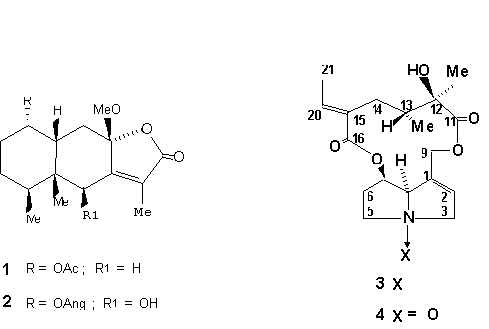
1Instituto de Productos Naturales y Agrobiología, IPNA-CSIC, La Laguna-Tenerife, Spain.
2Centro de Ciencias Medioambientales, CCMA-CSIC, Madrid, Spain.
3UDI Fitopatología, Facultad de Biología, Universidad de La Laguna, Tenerife, Spain.
4Facultad de Química y Biología, Universidad de Santiago de Chile (USACH), Santiago, Chile.
5Facultad de Ciencias, Universidad de Magallanes, Punta Arenas, Chile.
The genus Senecio is widely distributed through the world and it is a well
known source of pyrrolizidine alkaloids, sesquiterpenes and benzofurans of biological interest.
In this work we have studied the phytochemistry and biological effects of Senecio
miser Hook, a small shrub endemic to the Chilean Patagonia. Two new sesquiterpenes
1alpha-acetoxi- 10betaH,8beta- methoxi- eremophil- 7(11)-en- 8alpha,12-olide (
1) and 1alpha- angeloiloxi-6beta- hydroxi- 10betaH,8beta- methoxi-
eremophil- 7(11)- 8alpha,12-olide (2) plus the pyrrolizidine alkaloids
integerrimine (3) and its N-oxide (4) have
been isolated from this plant and their biological effects against insects and fungal pathogens
studied. Compound 1 was a strong antifeedant against the Colorado
potato beetle (Leptinotarsa decemlineata) in choice and no-choice tests, while
2 was only active in choice tests. None of these compounds were
toxic to this beetle or showed any antifungal effects against Fusarium moniliforme. However,
its parent fraction was a strong antifungal suggesting synergistic effects.
